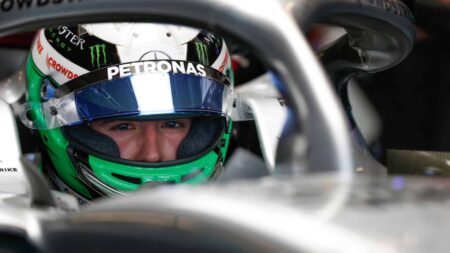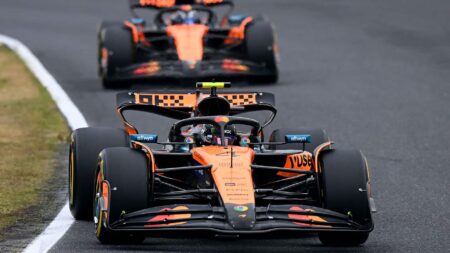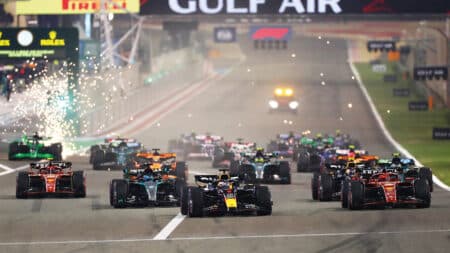
Who are all the F1 rookies driving in Bahrain GP FP1?
The Bahrain Grand Prix is set to have a very different line-up during first Friday practice as six rookies replace F1 drivers at their parent teams. Here's all you need to know about them
The first test session of the F1 season always sees a flurry of excitement, and Jerez this week was no different. Four 2013 cars were unveiled to the media for the first time, and five others made their maiden public appearances at the circuit, with Force India having undertaken a brief shakedown on its launch at Silverstone the previous Friday.
The only team with not much new to show us was Williams, Sir Frank’s men having opted some time ago to spend a couple more weeks on R&D. The FW35 will take to the track at the start of the second test in Barcelona on February 19.
This year’s crop of new cars was never going to be technically fascinating given a) the continuity in the rules and b) the massive package of changes coming for the turbo era in 2014, which Lotus technical director James Allison rather colourfully likened to a “tsumani.”
All the major teams have already devoted considerable resources to their 2014 programmes, and even the smaller outfits have had a bit of a look and are preparing to ramp up their research in the coming months, way ahead of the normal new car schedule. Given that scenario, no team was going to invest in anything too radical, as it would have a shelf life of just a year. The familiar new car cliché “it’s an evolution of last year’s” has been spouted a lot in the last couple of weeks.
The one change that we’ve been able to talk about is the possibility to use a vanity or modesty panel to hide the bumps atop the nose that appeared last year, and which made the 2012 cars perhaps the ugliest of recent times. The good news is that many teams have indeed taken advantage and incorporated a hollow area at the top of the nose. It’s covered by a piece of carbon that shatters in T-bone impacts, which is the reason why we got the unloved low noses last year.
However not all teams have done it, so there are still a few bumps. As each new car was launched its bemused technical director had to patiently explain why his team had or had not smoothed out its nose, and the pros and cons of that decision. To them it was a minor, minor issue, but we all asked because it was something we could see. As ever the really important stuff is beneath the skin, if indeed it is even on the cars at all yet…
And that’s why it’s not worth getting too excited about the minutiae of modern F1 testing, and especially the first session. Not only do the teams have their own agendas, with lots of routine data gathering and function tests to conduct, the cars we saw in Spain this week will in most cases change considerably by the third and final test in Barcelona, and even more so by the first race in Melbourne. And Australia will just be the start of the now familiar development race that will continue deep into the season.
Earlier in the week Mark Webber made it clear that for Red Bull, Jerez was all about getting some pretty routine homework done.
“The run plan this morning was pretty ambitious, but we have a lot of departments in the team looking for feedback, so it was important to get through the list,” he explained. “We accomplished most of it and that’s all you can ask for. People always ask about the times being done up and down the pit lane but, to be honest, I haven’t looked. We can only look at what we’re doing, and so far we’re satisfied with where we are.”
Testing is and always has been about reliability, but inevitably issues encountered at the first test – where drivers are new to teams and there’s a heavy media presence – get a lot of attention. Things could hardly have gone any worse for Mercedes as the world focussed on Lewis Hamilton and how he fared in his new home.
First Nico Rosberg came to a smoky halt on Tuesday after a wiring loom problem caused a minor fire. Then when Lewis had his first go on Wednesday a brake line issue saw him skate off into the tyre wall. Between them the two drivers managed just 29 laps over those two days, and few of those were conducted at proper racing speeds.
This was usual testing stuff, and others also had glitches – Jenson Button and McLaren lost most of Tuesday to a fuel pump failure (a Mercedes item, it has to be said!). But the words “brake failure” and “crash” inevitably created a lot of headlines, and it wasn’t the sort of thing that either team or driver really needed on their first proper day together. Mercedes made up for lost time with two full days with Nico on Thursday and again with Lewis today, and no doubt the early hiccups will quickly be forgotten.
As for what we’ve really learned from the four days, no one can really say with any certainty, for the reasons already mentioned. Having said that it seems that none of the big players have any disastrous issues to contend with, in contrast to this time last year, when Ferrari already knew that the F2012 had some serious flaws.
The fact that Fernando Alonso went on to very nearly win the World Championship says much about how much we should draw on the results of the first test. Mercedes might have stumbled at the first hurdle with the W04, but it’s way too early to draw any conclusions.
“Even when we’re all here together you’re never quite sure what other people are doing,” said Ross Brawn today. “But Nico’s obviously the best judge of what we had last year and what we have now, and he seems pretty enthusiastic.”
Perhaps Alonso expressed it best, not even turning up in Jerez after convincing Ferrari that it would be better if he saved up his precious track days for the two Barcelona tests, by which time things will get a little more serious, leaving Felipe Massa and new recruit Pedro de la Rosa to do the donkey work. Indeed Massa set the fastest time of the week, albeit on a soft tyre run, and even the Brazilian wasn’t getting too excited. There’s still a long way to go…

The Bahrain Grand Prix is set to have a very different line-up during first Friday practice as six rookies replace F1 drivers at their parent teams. Here's all you need to know about them

Lando Norris leads Max Verstappen by a single point going into the fourth round of the season in the Bahrain GP following the Red Bull driver's win in Japan. Here's what to look out for at Sakhir

Formula 1 heads to Sakhir for the Bahrain Grand Prix this weekend, but which drivers have had the most success at this special circuit before? From the highest number of podiums, pole positions and wins, here are all the stats for you to get stuck into

The 2025 Formula 1 season is set to hot up in Sakhir – watch F1 via live stream or on TV: dates and start time for the 2025 Bahrain Grand Prix